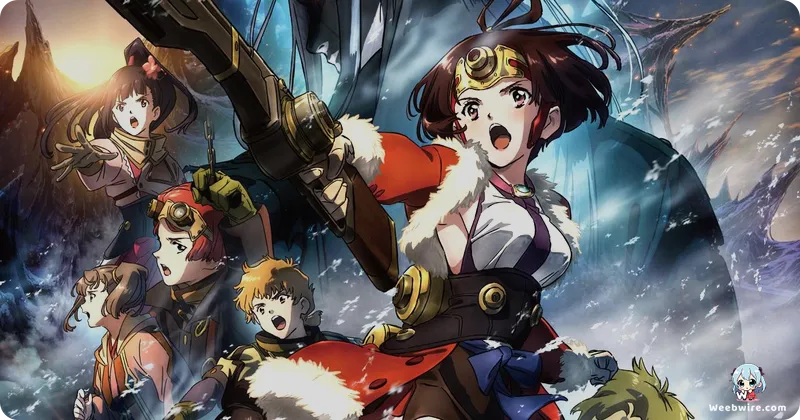Unveiling the Core: Kabaneri of the Iron Fortress – The Battle of Unato's Deepest Secrets and Artistic Triumphs

While Kabaneri of the Iron Fortress: The Battle of Unato is widely celebrated for its explosive, steam-powered combat sequences and relentless action, a deeper dive into this cinematic continuation reveals a wealth of intricate details and production brilliance that are often overlooked. This film meticulously expands upon the world ravaged by the formidable Kabane, unveiling rich lore, profound character development, and remarkable artistic nuances that elevate it beyond a mere action spectacle. It serves as a powerful testament to the creators' dedication to masterful world-building and profound character exploration, offering far more substance than initially meets the eye.
At its core, the world of Kabaneri presents a truly unique fusion of steampunk technology, traditional Japanese aesthetics, and a brutal zombie-apocalypse narrative. The Kabane, humanity's relentless undead plague, possess a complex and fascinating biology: their sole vulnerability lies in a distinctive 'iron heart,' which is shielded by an impenetrable casing. This unique feature hints at a deeper, more enigmatic origin for the virus itself, suggesting a design rather than a random mutation. The Kabaneri, individuals who are infected yet manage to halt the virus's progression, exist precariously on the fringes of society, balancing their retained rationality with an ever-present bloodlust. The term 'Kabaneri' itself is a clever linguistic blend of 'Kabane' and 'jinrui' (human race), perfectly encapsulating their liminal status. This concept of being neither fully human nor fully Kabane drives much of the series' emotional tension, societal prejudice, and the internal struggles of its protagonists.
The Unparalleled Animation of WIT STUDIO
WIT STUDIO's renowned animation prowess truly shines in The Battle of Unato. Beyond the fluid and dynamic action sequences, an extraordinary level of detail was poured into rendering the intricate steampunk machinery. From the colossal Kotetsujyo locomotives, which serve as mobile fortresses, to Ikoma's ingenious inventions and Mumei's specialized combat gear, every single rivet, gear, and wisp of steam is rendered with breathtaking precision. This meticulous attention to mechanical detail creates a tangible sense of realism and immersion within the gritty, industrial world. Furthermore, animating the erratic, unpredictable movements of the Kabane, contrasted sharply with the precise, almost balletic combat styles of the Kabaneri, demanded exceptional individual frame-by-frame work. This pushed the boundaries of traditional animation, resulting in seamless, high-speed sequences that are both thrilling and visually stunning. This commitment to unparalleled craftsmanship further cements WIT STUDIO's reputation as a leader in the anime industry.

Hiroyuki Sawano's Electrifying Score
Another undeniable highlight of the film is Hiroyuki Sawano's electrifying musical score. His distinctive style, characterized by dramatic orchestral arrangements, powerful vocal tracks, and pulsating electronic elements, is an inseparable component of the narrative. Known for his unique, often cryptic song titles that add another layer of intrigue, Sawano's score masterfully intertwines traditional Japanese instruments with modern synth sounds. This blend perfectly mirrors the anime's unique setting, which combines feudal-era aesthetics with advanced, albeit steam-powered, technology. His music doesn't merely accompany the action; it propels it forward, elevating emotional stakes and imbuing every clash with an undeniable intensity and urgency that resonates long after the credits roll.
Characters with Surprising Depth
The characters in Kabaneri of the Iron Fortress, particularly Ikoma and Mumei, possess surprising and often overlooked depth. Ikoma, the protagonist, is not just lauded for his unwavering resolve but also displays profound empathy and an exceptional engineering genius. His primary motivation is to find a cure for the Kabane virus, a quest that leads him to self-experimentation and the creation of unique, steam-powered weaponry. Mumei, despite her lethal combat prowess and seemingly hardened exterior, is surprisingly childlike and emotionally vulnerable beneath her tough facade. Her true age, significantly younger than her appearance suggests, leads to moments of innocent curiosity and a deep, almost familial reliance on Ikoma. Her internal struggle with her traumatic past and her identity as a Kabaneri adds immense complexity to her character arc. The enduring bond between Ikoma and Mumei, rooted in their shared Kabaneri condition and mutual understanding, serves as the emotional bedrock of the series, driving their individual growth and their collective fight for humanity's future.
Narrative Expansion and Global Reach
The Battle of Unato also offered intriguing aspects regarding its release strategy and narrative expansion. As a direct sequel to the TV series, it provided crucial continuity, significantly expanding the world beyond the confines of the Kotetsujyo and the isolated stations. The film delved into new dimensions of the Kabane threat, introducing evolved forms and exploring complex societal dilemmas that arise from humanity's desperate struggle for survival. Its initial global streaming release on Netflix, chosen over traditional theatrical runs in many regions, underscored its international appeal and made it immediately accessible to a vast worldwide audience. This strategic release allowed Unato to delve deeper into the lore of the 'Black Smoke' and Kabane evolutions, pushing the narrative beyond simple monster-slaying to explore themes of survival, adaptation, and the moral ambiguities of a world on the brink. Ultimately, these insights illuminate why this film resonated deeply with countless viewers and remains a compelling entry in the steampunk-apocalyptic genre.
Credits
Kabaneri of the Iron Fortress: The Battle of Unato
Author
Original Concept: WIT STUDIO
Cover Art
Yasuyuki Ebara
Studio
WIT STUDIO
Publisher
Kabaneri Production Committee
Producers





